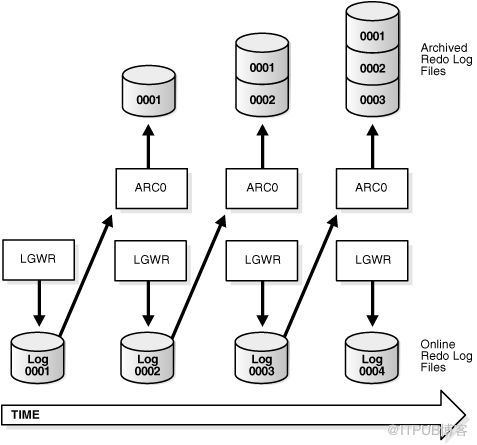Archived Redo Logs归档重做日志介绍及其优点
Redo Log File Use in ARCHIVELOG Mode
什么是Archived Redo Logs?
Oracle Database lets you save filled groups of redo log files to one or more offline destinations, known collectively as the archived redo log.
1.将写满的重做日志保存到1个或多个脱机的目录,统称为归档重做日志。
The process of turning redo log files into archived redo log files is called archiving.
2.将重做日志文件转换为归档重做日志文件的过程称为归档。
This process is only possible if the database is running in ARCHIVELOG mode.
3.数据库只在ARCHIVELOG模式下执行归档操作。
You can choose automatic or manual archiving.
4.可以选择自动或手动归档。
An archived redo log file is a copy of one of the filled members of a redo log group.
5.归档重做日志是一组写满的重做日志中某一个的副本。
It includes the redo entries and the unique log sequence number of the identical member of the redo log group.
6.归档重做日志包括重做条目和重做日志组相同成员的唯一日志序列号。
The archived redo log contains a copy of every group created since you enabled archiving.
7.归档重做日志包含自您启用归档后创建的每个重做日志组的副本。
When the database is running in ARCHIVELOG mode, the log writer process (LGWR) cannot reuse and hence overwrite a redo log group until it has been archived.
8.如果数据库运行在ARCHIVELOG模式下,在重做日志完成归档操作之前,LGWR进程不能重用和覆盖重做日志。
The background process ARCn automates archiving operations when automatic archiving is enabled.
9.后台进程ARCn在启用自动归档时自动执行归档操作。
The database starts multiple archiver processes as needed to ensure that the archiving of filled redo logs does not fall behind.
10.数据库根据需要启动多个归档进程,以保证归档的速度。
归档重做日志可以做什么?
Recover a database
1.恢复数据库
Update a standby database
2.更新备用数据库
Get information about the history of a database using the LogMiner utility
3.使用LogMiner获取数据库历史信息
为什么选择归档模式?
If a media failure occurs while the database is in NOARCHIVELOG mode, you can only restore the database to the point of the most recent full database backup. You cannot recover transactions subsequent to that backup.
非归档模式下,如果发生介质故障,如果没有最近的数据全量备份,那么数据丢失就不可避免。即使有最近的数据全量备份,也会大概率丢失部分数据。
归档日志的优点
A database backup, together with online and archived redo log files, guarantees that you can recover all committed transactions in the event of an operating system or disk failure.
1.可以确保在系统或硬盘故障情况下恢复数据。
If you keep archived logs available, you can use a backup taken while the database is open and in normal system use.
2.如果保留了可用的归档日志,可以在不影响数据库正常运行的情况下进行备份操作。
You can keep a standby database current with its original database by continuously applying the original archived redo logs to the standby.
3.将归档重做日志连续应用到备库,可以保证主备库数据一致。
You can configure an instance to archive filled redo log files automatically, or you can archive manually. For convenience and efficiency, automatic archiving is usually best.
4.可以自动也可以手动归档,当然最好是自动归档。
If all databases in a distributed database operate in ARCHIVELOG mode, you can perform coordinated distributed database recovery. However, if any database in a distributed database is in NOARCHIVELOG mode, recovery of a global distributed database (to make all databases consistent) is limited by the last full backup of any database operating in NOARCHIVELOG mode.
5.如果分布式数据库中的所有节点都以ARCHIVELOG模式运行,则可以执行协调的分布式数据库恢复。
提示:将归档的重做日志文件和相应的数据库备份从本地磁盘移动到永久脱机存储介质(如磁带)是一种很好的做法。即使发生地震、洪水等不可抗拒自然灾害,也能确保数据的安全。当然,异地灾备、两地三中心等技术架构也能防止自然灾害的威胁。
来自 “ ITPUB博客 ” ,链接:http://blog.itpub.net/31394774/viewspace-2285522/,如需转载,请注明出处,否则将追究法律责任。
转载于:http://blog.itpub.net/31394774/viewspace-2285522/
